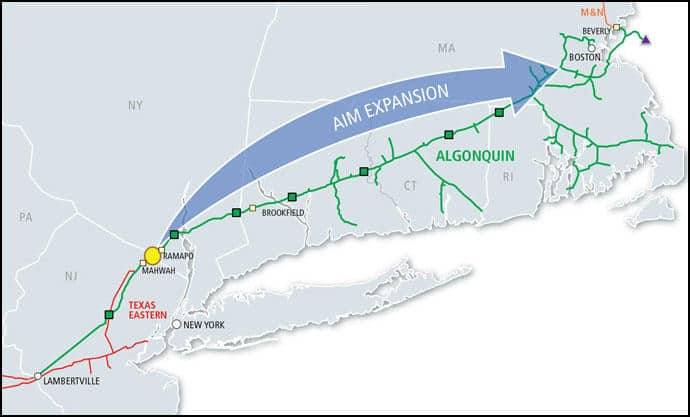In a potential conflict of interest, a contractor hired by the Federal Energy Regulatory Commission (FERC) to review a proposed Spectra Energy natural gas pipeline project had already been working for the company it was reviewing on a different but interconnected pipeline. Spectra then directly hired the contractor, Natural Resource Group (NRG), for no fewer than five other projects during the review period.
These revelations raise questions about the contractor’s ability to impartially review Spectra’s application on behalf of the government regulator.
In June 2013, FERC approved the hiring of NRG as a third-party contractor to conduct a comprehensive environmental review for Spectra’s then-proposed Algonquin Incremental Market (AIM) project, a major capacity upgrade for its Algonquin Pipeline carrying fracked gas from Pennsylvania through New York and into New England.
While third-party contractors are paid by the pipeline company seeking FERC approval, they are considered independent analysts who work under the direct supervision of FERC staff.
Yet DeSmog has found that during the time of its hiring for AIM, NRG was providing environmental consulting services for two of Spectra’s pipeline testing and renewal projects on its Texas Eastern Transmission Pipeline, which interconnects with the Algonquin Pipeline.
Records from the Arkansas Department of Environmental Quality show that the two Spectra projects, Hope 2013 DOT and Donaldson Site 1 2013 DOT, were carried out in the first half of 2013 and continued through July—that is, after FERC hired NRG to review Spectra’s AIM project.
Then, within months after NRG began reviewing Spectra’s AIM project as FERC’s contractor, Spectra hired it to work on five of its other projects.
Two of them, Line 2-H and 2-H-1 Abandonment, and Bailey East Mine Panel 2L, were on the Texas Eastern Pipeline. Another project, Ozark Gas Abandonment, was on Spectra’s Ozark Gas Pipeline, which interconnects with Texas Eastern. A fourth one involved Spectra’s new crude oil pipeline in the Midwest.
Finally, in October 2014 Spectra joined the PennEast Pipeline Company, a major pipeline consortium, which at the time was already employing NRG to perform public affairs work. The PennEast consortium, of which Spectra is a member, plans to connect to Algonquin Pipeline.
By hiring NRG directly for these additional projects, Spectra may have incentivized the contractor during the time it performed AIM’s environmental review on the government’s behalf.
FERC published AIM’s final Environmental Impact Statement (EIS) in January 2015. The EIS, written largely by NRG employees, provided an overall positive assessment for Spectra, concluding that AIM’s “most [environmental] impacts would be reduced to less-than-significant levels” and essentially green-lighting the project. FERC went on to approve AIM, which is now under construction.
RELATED DESMOG ARTICLE: Former Inspectors Describe Dangerous Flaws in Construction of Major East Coast Gas Pipeline
To Disclose or Not to Disclose?
FERC’s guidelines for hiring third-party contractors require such contractors to disclose all relationships with FERC-regulated pipelines and related oil and gas companies. To avoid conflict of interest, contractors must be vetted by the applicant company and receive final approval from FERC. The guidelines explicitly include cases where a contractor enters into relationships with companies during the time it works as third-party contractor. In such cases, the third-party contractor must notify FERC.
Responding to DeSmog’s request for comment, a FERC spokesperson said that working directly for an applicant company does not automatically disqualify a contractor from working as third-party consultant. Rather, it is a matter of the company’s proportional presence in the contractor’s current and recent business portfolio, FERC’s spokesperson Craig Cano said.
For AIM, FERC determined that NRG’s work for Spectra fell below the level of conflict of interest.
“Under the direction of the Commission’s Designated Agency Ethics officials,” Cano said, “the Commission’s General and Administrative Law Section of the Office of the General Counsel performs an organizational conflict of interest review for each of the contractors by reviewing any relationships between the contractor and any business entity that could be affected in any way by the proposed work done under the contract. In general, if less than one percent of a contractor’s business (for the current and preceding year) concerns a party that could be affected by the work being done, then the contractor is not considered to have a conflict of interest. NRG fell below the one-percent level.”
However, Cano said that NRG did not report any changes to its portfolio, with regard to its work for Spectra, during the environmental review for its AIM project.
This suggests that notifications on the other projects NRG performed directly for Spectra during that timeframe were not relayed to FERC, as the Commission’s guidelines mandate. “NRG was under an obligation to report any change in circumstances,” says Cano. “FERC did not receive any notice. The Commission makes its determinations based on the information provided by companies.”
Both NRG and Spectra Energy did not respond to repeated requests for comment.
A History of Potential Conflicts
These revelations follow DeSmog’s earlier reporting on an apparent conflict of interest in FERC’s hiring of NRG to review Atlantic Bridge, another proposed Spectra project on its Algonquin Pipeline. NRG was hired as third-party contractor for Atlantic Bridge after Spectra joined PennEast, suggesting NRG had an interest in approving Atlantic Bridge.
In the wake of that revelation, US Senators from Massachusetts, Elizabeth Warren and Ed Markey, wrote a letter to FERC Chairperson Norman Bay demanding answers and requesting FERC issue an objective environmental assessment for the Atlantic Bridge project.
Image credit: Spectra Energy via WAMC
Subscribe to our newsletter
Stay up to date with DeSmog news and alerts






